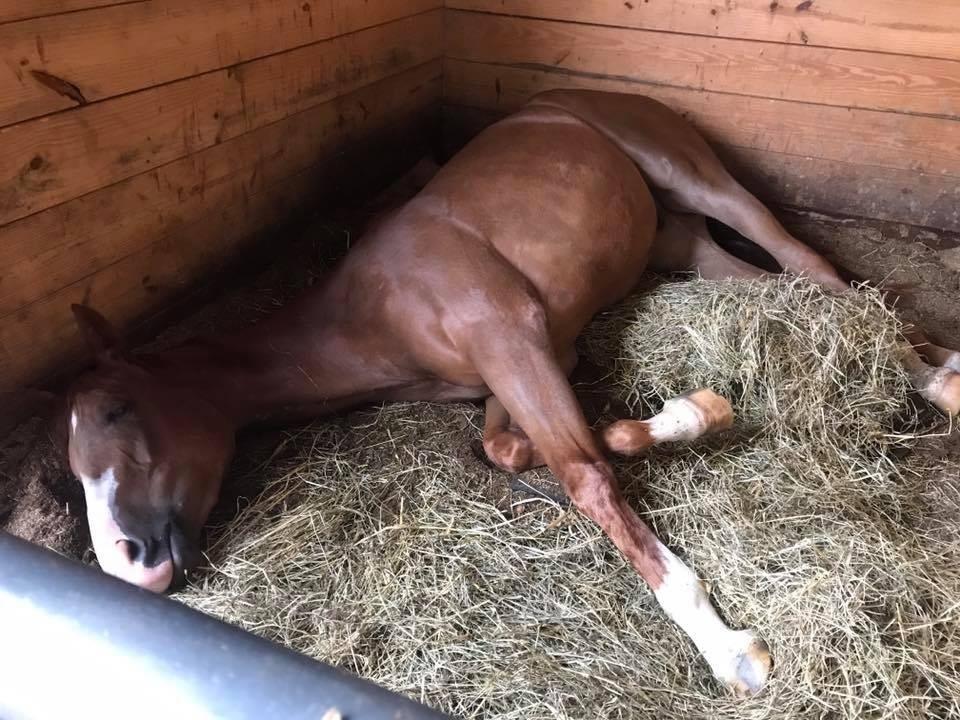
Mythbuster Monday: Horses Can Only Achieve REM Sleep Lying Down
On Mythbuster Monday, we tackle a variety of equestrian myths to either bust or confirm. Today’s discussion: Can horses only achieve REM sleep while laying down?
It’s Mythbuster Monday, where Horse Nation dives into different equestrian myths and provides research-based evidence to either bust or confirm those myths. Today’s topic: Can horses only achieve REM sleep laying down? Read further to find out!
Myth: Horses can only achieve REM sleep laying down.
Myth or Fact: Fact
REM stands for rapid eye movement. This is the part of the sleep cycle where your eyes move around but don’t relay any visuals to your brain. Dreaming typically happens during REM sleep.
While humans need approximately eight hours of sleep in a 24 hour period, horses only require three hours in a 24 hour period. The total amount of REM sleep a horse needs per day is approximately 30 – 40 minutes. However, horses can not get this sleep while standing.
In an article interviewing Dr. Monica Aleman of the University of California Davis Large Animal Clinic, Aleman states that when horses go into their REM sleep while standing, the horse will collapse and stumble. She goes on to explain how horses lose the muscle tone when in the REM sleep part of the cycle.
She then discusses how the horse needs to either be lying chest down or on his side and that it may be very brief. Horses don’t get all their REM sleep at one time. It may just be for a few moments or seconds.
Another article by the Kentucky Equine Research Staff acknowledges that horses do sleep standing up, but at some point during the day they must lie down to fulfill the entire sleep cycle.
This article goes on to discuss the importance of the horse lying down to obtain REM sleep. If the horse can not lay down due to unsuitable environmental conditions, insecurity with pasture mates or physical issues, he can suffer from REM deficiency and will become excessively drowsy.
Dr. Sue McDonnell, head of the Equine Behavior Lab at the University of Pennsylvania’s School of Veterinary Medicine, speaks in an article about horse sleep patterns. Dr. McDonnell has been studying horse sleep patterns for the past 20 years and has gathered data from domesticated and wild horses. She states that horse sleep patterns evolved from being prey species on open plains.
Dr. McDonnell explains that a horse can sleep standing up because they have an “internal hammock system.” This is when the horse locks his legs into position so he can doze off. However, this type of sleep does not complete the sleep cycle. At some point during the day horses need to lie down for REM sleep. Dr. McConnell goes on to say that in her experience this type of sleep mostly happens when the horse is stretched out flat on his side.
Dr. Katherine Houpt, professor at Cornell University’s College of Veterinary Medicine, speaks in an article about horse sleep deprivation. She states the importance of horses having the means to lie down when obtaining REM sleep. If a horse is deprived of sleep it will go into its REM sleep standing up and its legs will buckle and the horse will drop to the ground, usually onto its knees.
In Dr. Houpt’s experience, horses who are pastured lay down more and obtain more REM sleep than those that are stalled. However, she states that a horse with thick bedding in its stall is going the get more REM sleep than a horse sleeping in a dirt lot, but horses with a grassy pasture tend to get the most REM sleep because it is comfortable to lay down.
After diving into the research, horses need a total of 30 – 40 minutes of REM sleep. The experts all state that horses can only obtain REM sleep while lying down. If exhausted and sleep deprived they can enter into the REM sleep cycle but will fall onto their knees.
Do you have an equine myth you’d like us to tackle? If so, send it our way! Email your suggestions to [email protected]. Put Mythbuster Monday in your subject line.










